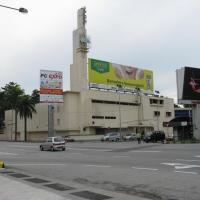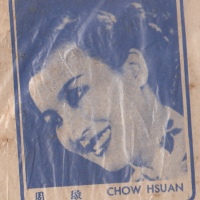“Run over here and sit on my lap,” Dad gestured to me one evening after a simple dinner.
I was in the kitchen, observing Grandma and Mom making “Far Sang Kok” or peanut puffs with coarse sugar. Grandma was gently rolling a piece of dough with a glass bottle on the table while Mom was sitting on a small wooden stool, diligently grinding some roasted peanuts in a stone mortar with a pestle.
Chinese New Year is just around the corner and we had already cleaned up Dad’s coffee shop the night before. It was time to prepare some delicacies such as “Far Sang Kok” and “Har Bang” or prawn crackers. These snacks go down very well with “Sarsi” or “F & N” and for kids, this is heavenly!
“Come, let me tell you the story why we celebrate Chinese New Year, why we wear red clothes and light up firecrackers,” Dad offered as I sat myself comfortably on his lap. I think he wanted to lure me away from the wok which was filled with hot boiling oil, readied to fry the puffs and crackers.
“It all started with one word – fear,” he said, before going into the story behind the annual spring festival.
“Long ago, in some remote mountains in ancient China,” he began, “lived a ferocious beast called Nian (simplified Chinese: 年兽; traditional Chinese: 年獸; pinyin: nián shòu). It has the look of a lion. Nian loved to hibernate during the long winter months. It slept and slept the days away. When spring finally come, the snow melts and the sun’s rays came shining through. It’s time Nian wakes up and goes searching for food to fill its hungry belly,” my father recounted, tickling my stomach to emphasize how hungry the beast must be and I burst into childish giggles.
“Now, Nian was a carnivorous beast. It loves to devour every little animal in sight. Unsatisfied with this, it would make its way to the nearby villages to prey on the peasants and their families. One by one, children were eaten up and this got the people terrified. The villagers were at a lost as to how to get rid of this dreadful beast. Life became a misery for them,” he sighed.
“One day, a wise old man paid a visit to the villagers. He was actually a benevolent fairy in disguise. He heard that the beast was afraid of red colors and loud noises.”
“Hang some red lanterns and banners outside your homes. Put on red clothes. Bring out your drums, gongs and cymbals. Create as much noises as you can with these instruments. Better still, light up some firecrackers. Red colors and loud noises will frighten the beast away. Give it a try to see whether this method works or not, the old man suggested to the worried people.”
“Left without much choices and living in constant fear of losing more young lives, the people got together and did as were told by the stranger when they sensed that the beast was in their vicinity. They hung red paper lanterns and red cloth banners at their doorsteps. Strings and strings of firecrackers were lit up to the thunderous sounds of drums and gongs,” Dad went on.
“Sure enough, the sight of a sea of red colors and the pulsating noises in the villages sent Nian fleeing as far as its legs could carry it. Seeing the beast had run away, the people were jubilant. They rejoiced by singing, dancing, feasting and congratulating each other for being able to drive the terrible beast away,” he said, locking his fists together to demonstrate how it was done in the Chinese way.
“From then onwards, when winter was over and spring approaches, the people would hang red lanterns and banners outside their doorsteps. They would beat their drums and gongs while letting off firecrackers. All these were done to prevent Nian from coming back. They feared the beast will return to take revenge on them. Of course Nian dare not come back anymore to create havoc when spring arrives,” my father said smilingly.
“Some auspicious terms were coined to describe this annual observation. ‘Nian’ is now used to describe the period of one spring to another, roughly about twelve months or one year. So when you hear somebody says ‘Xin Nian Dao 新年到’ it means a new year has arrived. ‘Guo Xin Nian 过新年’ means moving from the old year into the new one. To congratulate each other for surviving Nian Shou’s cruel onslaughts, we say ‘Gong Xi, Gong Xi 恭喜,恭喜’ when we meet up with friends and relatives. It is a way to express our happiness for being safe from the beast’s path,” Dad explained to me.
“The practice of hanging red items on the doorsteps, beating on the drums and gongs as well as letting off firecrackers soon spread to other villages throughout the empire. Later, lion and dragon dances were incorporated into the celebration too, to create more vibrancy and noises. This practice persisted on to all corners of the globe wherever the people goes,” my father concluded.
So this is what Dad told me and it remained with me all these years. I always think of this story which I heard as a little girl when Chinese New Year is drawing near. My children and I simply loved it; hope you do too!










Thank you for your dad’s wonderful story of New year! So that’s what all the noise is about….:D
Gong Xi Fa Cai to you! May it be a wonderful Rabbit Year for you and yours.
Sorry, I thought you meant 2012 was the year of the Rabbit. I wasn’t aware of what this year was…so here’s to a wonderful Dragon Year! 😀
Hi Sheila,
Yes, you are right, we are actually at the tail’s end of the Rabbit Year. Next Monday, January 23rd 2012, will see the Dragon making it’s grand entrance.
Hahaha, now you know why the celebration is so boisterous and crimson, don’t you? The louder and redder the better in keeping all the bad and evil at bay!
Gong Xi Fa Cai to one and all!
Thanks for sharing the lovely story 🙂 I can’t wait to tell Ashley about this 🙂
Hi Barb,
Hope Ashley will like it too and not got frighten by the beast!